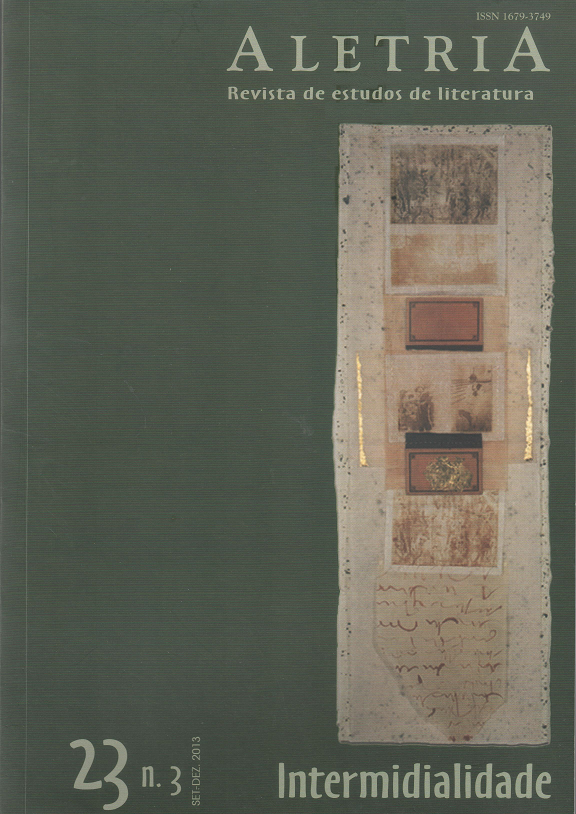A virada performativa em Inhotim: as instalações e a modernidade baudelairiana
DOI:
https://doi.org/10.17851/2317-2096.23.3.13-30Palavras-chave:
Inhotim, instalação, modernidade baudelaireana, pós-modernidadeResumo
Este artigo explora a virada participativa na arte da instalação como parte da trajetória da modernidade baudelairiana até a posmodernidade do século XXI, representada por Inhotim, museu de arte contemporânea ao ar livre e jardim botânico, em Brumadinho, Minas Gerais. Em seu ensaio de 1862, “O pintor da vida moderna”, Charles Baudelaire definiu a modernidade como evanescente, transitória e fragmentária. A modernidade baudelairiana iniciou uma ruptura de fronteiras entre a arte e a vida, e entre a estética das Artes e a cultura popular, que continua nas instalações artísticas atuais. Nos locais das instalações, o espectador é forçado a expandir – em vez de completar – a obra de arte, em seu próprio ritmo, bem como suas experiências anteriores e reflexões posteriores. A mudança de uma obra de arte isolada para uma vivenciada não apenas complica o modo e o lugar em que as obras de arte são vistas, mas também radicaliza os materiais que constituem a obra de arte. Quer esses materiais sejam extraídos da esfera cotidiana, quer sejam extraídos de tecnologias complexas, cada obra passa por um processo de desfamiliarização e reativação para produzir a experiência estética transformadora. As instalações desse museu a céu aberto levam o espectador a uma experiência dinâmica e participativa com as relações espaciais, temporais e materiais que definem a própria essência da reciprocidade da arte, ou contrastam com o mundo, tanto o natural quanto o construído. E o cenário rarefeito do Jardim Botânico de Inhotim que faz com que a experiência participativa e transformadora se torne central para o encontro estético com a arte da instalação.
Downloads
Referências
BARCENA, Bryan. The Senses at Play: Dan Graham at Inhotim. Unpublished paper written for the seminar “Global Installation Art” (Fall 2011).
BAUDELAIRE, Charles. The Exposition Universelle (1855). In: BAUDELAIRE, Charles. Art in Paris 1845-1862: Salons and Other Exhibitions. Translated and edited by Jonathan Mayne. Oxford: Phaidon, 1965. p. 121-143.
BAUDELAIRE, Charles. The Painter of Modern Life. In: BAUDELAIRE, Charles. Selected Writings on Art and Literature. Translated and edited by P. E. Charvet. London; New York: Penguin, 1992. p. 390-435.
BAUDELAIRE, Charles. Salon of 1846: XVII of the Heroism of Modern Life. In:
BAUDELAIRE, Charles. Selected Writings on Art and Literature. Translated and edited by P. E. Charvet. London; New York: Penguin, 1992. p. 104-107.
BENDER, Stephanie. Doug Aitken’s Sonic Pavilion (2009). Unpublished paper written for the seminar “Global Installation Art” (Fall 2011).
BISHOP, Claire. Installation Art: A Critical History. New York: Routledge, 2005.
BRETON, André. The First Surrealist Manifesto (1924). In: HARRISON, Charles; WOOD, Paul (Ed.). Art in Theory, 1900-2000: An Anthology of Changing Ideas. Malden, Mass.: Blackwell, 2002. p. 447-453.
CC3-MAILERYN. Quasi Cinema (Block-Experiment in Cosmococa-Program in Progress). Museu d’Art Contemporani de Barcelona, Collection/Holdings. Available on: http://www.macba.cat/en/cc3-maileryn-quasi-cinema. Accessed: Mar. 2012.
DUCHAMP, Marcel. The Richard Mutt Case (Letter to The Blind Man, May 1917). In: HARRISON, Charles; WOOD, Paul (Ed.). Art in Theory, 1900-1990: An Anthology of Changing Ideas. Oxford, UK: Blackwell, 1993. p. 248.
DUCHAMP, Marcel. The Creative Act (1957). In: LEBEL, Robert. Marcel Duchamp. New York: Paragraphic Books, 1959. p. 77-78.
EXCLUSIVES: Doug Aitken. AnOther Magazine, February 2, 2010. Available on: http://www.anothermag.com/exclusives/dougaitken. Accessed: Mar. 2012.
KAPROW, Alan. The Legacy of Jackson Pollock (1958). In: KELLEY, Jeff (Ed.). Essays on the Blurring of Art and Life. Berkeley: University of California Press, 1993. p. 1-9.
KIM-COHEN, Seth. The Hole Truth: On Doug Aitken’s Sonic Pavilion. Artforum, v. 48, n. 3, p. 99-100, November 2009.
MEIRELES, Cildo. Interview with John Alan Farmer: Through the Labyrinth: An Interview with Cildo Meireles, Art Journal, v. 59, n. 3, p. 34-43, Autumn 2000.
METZ, Mike. Interview with Dan Graham. BOMB Magazine, n. 46, n. p., Winter 1994. Available in: http://bombsite.com/issues/46/articles/1722. Accessed: Mar. 2012.
MAHAN, Nicole. Olafur Eliasson’s Viewing Machine: Kaleidoscopic Vision in the Twenty-First Century. Unpublished paper written for the seminar “Global Installation Art” (Fall 2011).
RIBEIRO, José Augusto. Hélio Oiticica and Neville d’Almeida. In: SCHWARTZMAN, Alan et al. (Ed.). Through: Inhotim. Brumadinho, Brazil: Instituto Inhotim, 2009. p. 148-151.
SCHWARTZMAN, Alan et al. (Ed.). Through: Inhotim. Brumadinho, Brazil: Instituto Inhotim, 2009.
Downloads
Publicado
Edição
Seção
Licença
Copyright (c) 2013 Lauren S. Weingarden (Autor)

Este trabalho está licenciado sob uma licença Creative Commons Attribution 4.0 International License.
Autores que publicam nesta revista concordam com os seguintes termos:Autores mantém os direitos autorais e concedem à revista o direito de primeira publicação, com o trabalho simultaneamente licenciado sob a Licença Creative Commons Attribution que permite o compartilhamento do trabalho com reconhecimento da autoria e publicação inicial nesta revista.Autores têm autorização para assumir contratos adicionais separadamente, para distribuição não-exclusiva da versão do trabalho publicada nesta revista (ex.: publicar em repositório institucional ou como capítulo de livro), com reconhecimento de autoria e publicação inicial nesta revista.Autores têm permissão e são estimulados a publicar e distribuir seu trabalho online (ex.: em repositórios institucionais ou na sua página pessoal) a qualquer ponto antes ou durante o processo editorial, já que isso pode gerar alterações produtivas, bem como aumentar o impacto e a citação do trabalho publicado (Veja The Effect of Open Access).














